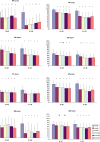The long-term impact of severe acute respiratory syndrome on pulmonary function, exercise capacity and health status
- PMID: 20337995
- PMCID: PMC7192220
- DOI: 10.1111/j.1440-1843.2010.01720.x
The long-term impact of severe acute respiratory syndrome on pulmonary function, exercise capacity and health status
Abstract
Background and objective: Severe acute respiratory syndrome (SARS) emerged in 2003 and its long-term sequelae remain largely unclear. This study examined the long-term outcome of pulmonary function, exercise capacity, health and work status among SARS survivors.
Methods: A prospective cohort study of SARS patients at the Prince of Wales Hospital, Hong Kong was conducted, with serial assessments of lung function, 6MWD and 36 item Short Form General Health Survey at 3, 6, 12, 18 and 24 months after disease onset. The work status was also recorded.
Results: Serial assessments were completed by 55 of the 123 (39.9%) subjects, of whom 27 were health-care workers (HCW). The mean age of the group was 44.4 (SD 13.2) years and 19 (34.5%) were males. At 24 months, 10 (18.2%), 9 (16.4%), 6 (10.9%) and 29 (52.7%) subjects had FEV(1), FVC, TLC and DL(CO) < 80% of predicted values, respectively. The mean (SD) 6MWD increased significantly from 439.0 (89.1) m at 3 months to 460.1 (102.8) m at 6 months (P 0.016) and became steady after 6 months. However, 6MWD and 36 item Short Form General Health Survey scores were lower than the normal population throughout the study. Moreover, 29.6% of HCW and 7.1% of non-HCW had not returned to work 2 years after illness onset.
Conclusions: This 2-year study of a selected population of SARS survivors, showed significant impairment of DL(CO), exercise capacity and health status persisted, with a more marked adverse impact among HCW.
Figures

Similar articles
-
The 1-year impact of severe acute respiratory syndrome on pulmonary function, exercise capacity, and quality of life in a cohort of survivors.Chest. 2005 Oct;128(4):2247-61. doi: 10.1378/chest.128.4.2247. Chest. 2005. PMID: 16236881 Free PMC article.
-
Impact of severe acute respiratory syndrome (SARS) on pulmonary function, functional capacity and quality of life in a cohort of survivors.Thorax. 2005 May;60(5):401-9. doi: 10.1136/thx.2004.030205. Thorax. 2005. PMID: 15860716 Free PMC article.
-
Medium-Term Disability and Long-Term Functional Impairment Persistence in Survivors of Severe COVID-19 ARDS: Clinical and Physiological Insights.Arch Bronconeumol. 2024 Oct;60(10):619-626. doi: 10.1016/j.arbres.2024.05.021. Epub 2024 May 28. Arch Bronconeumol. 2024. PMID: 38853119 English, Spanish.
-
Exercise capacity and pulmonary function in hospital workers recovered from severe acute respiratory syndrome.Respiration. 2007;74(5):511-6. doi: 10.1159/000095673. Epub 2006 Sep 5. Respiration. 2007. PMID: 16960439
-
Reduced Chest and Abdominal Wall Mobility and Their Relationship to Lung Function, Respiratory Muscle Strength, and Exercise Tolerance in Subjects With COPD.Respir Care. 2016 Nov;61(11):1472-1480. doi: 10.4187/respcare.04742. Epub 2016 Oct 18. Respir Care. 2016. PMID: 27794081
Cited by
-
Evaluation of pulmonary arterial stiffness in post mild COVID-19 patients: a pilot prospective study.J Cardiovasc Imaging. 2024 Aug 28;32(1):25. doi: 10.1186/s44348-024-00032-3. J Cardiovasc Imaging. 2024. PMID: 39198895 Free PMC article.
-
Post-acute sequelae of COVID-19 among hospitalized patients in Estonia: Nationwide matched cohort study.PLoS One. 2022 Nov 23;17(11):e0278057. doi: 10.1371/journal.pone.0278057. eCollection 2022. PLoS One. 2022. PMID: 36417409 Free PMC article.
-
Stem cell therapy for COVID-19, ARDS and pulmonary fibrosis.Cell Prolif. 2020 Dec;53(12):e12939. doi: 10.1111/cpr.12939. Epub 2020 Oct 24. Cell Prolif. 2020. PMID: 33098357 Free PMC article. Review.
-
Pathological sequelae of long-haul COVID.Nat Immunol. 2022 Feb;23(2):194-202. doi: 10.1038/s41590-021-01104-y. Epub 2022 Feb 1. Nat Immunol. 2022. PMID: 35105985 Free PMC article. Review.
-
COVID-19 and Long-Term Outcomes: Lessons from Other Critical Care Illnesses and Potential Mechanisms.Am J Respir Cell Mol Biol. 2022 Sep;67(3):275-283. doi: 10.1165/rcmb.2021-0374PS. Am J Respir Cell Mol Biol. 2022. PMID: 35348443 Free PMC article.
References
-
- Drosten C, Gunther S, Preiser W et al. Identification of a novel coronavirus in patients with severe acute respiratory syndrome. N. Engl. J. Med. 2003; 348: 1967–76. - PubMed
-
- World Health Organization . Summary of probable SARS cases with onset of illness from 1 November 2002 to 31 July, 2003. [Accessed 21 April 2004.] Available from URL: http://www.who.int/csr/sars/country/table2004_04_21/en
-
- Herridge MS, Cheung AM, Tansey CM et al. One‐year outcomes in survivors of the acute respiratory distress syndrome. N. Engl. J. Med. 2003; 348: 683–93. - PubMed
-
- Simpson DL, Goodman M, Spector SL et al. Long‐term follow‐up and bronchial reactivity testing in survivors of the adult respiratory distress syndrome. Am. Rev. Respir. Dis. 1978; 117: 449–54. - PubMed
Publication types
MeSH terms
LinkOut - more resources
Full Text Sources
Miscellaneous

